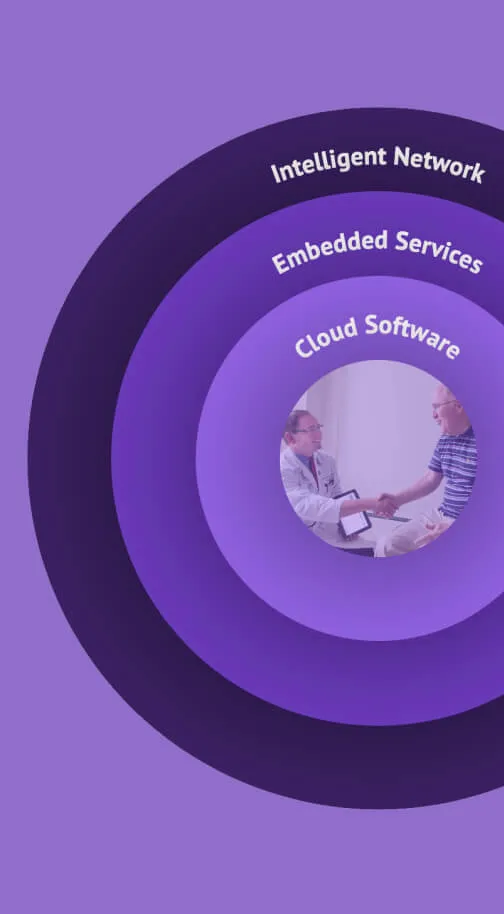Burnout poses a massive threat to the stability of the healthcare ecosystem. 49% of physicians feel burned out from work every week1 and 49% of administrative staff feel burned out a few times per month or more.2 For healthcare workers, there are an overwhelming number of tasks to complete during the work day, and physicians and staff are struggling to keep up.
What’s more, the risks associated with burned out clinicians and staff are high. Pervasive burnout leads to higher turnover and lower productivity — 56% of medical groups say staffing is their biggest productivity roadblock.3 And when burnout results in more employee turnover and staffing shortages, the downstream effects often negatively impact patient care. The more time healthcare organizations spend hiring and training new staff, the less they're able to focus on growing their business, patient retention, reducing gaps in patient care, and more.
Despite these significant negative effects, most healthcare organizations are struggling to address and prevent burnout, with 74% of physicians saying their organization hasn’t taken steps to reduce physician burnout in the last 12 months.1
To help your healthcare organization become better prepared to tackle burnout, we’ve culled through our recent industry data to help you determine the best places to start. Let’s dive a bit deeper.
Reduce the administrative burden to cut down on tasks and help you focus on patients
The administrative burden is a persistent, increasing source of burnout among clinicians. Many are overwhelmed by the mountain of administrative tasks they need to complete in a day, often taking this work home to complete another several hours of charting.
These tasks are critical to patient care, but healthcare organizations can implement new strategies to help reduce the time spent on non-clinical tasks. These strategies can include:
- Delegation: One option that works especially well at larger healthcare organizations is delegating as much encounter documentation work as possible. Support staff can manage certain tasks, giving clinicians time back to focus on the documentation tasks only they can do.
- Dictation technology: Some healthcare organizations may already be using scribes during the encounter, but leveraging dictation technology can be a cost-effective alternative. When clinicians are freed to focus on the patient in front of them, they’re better able to build trust, leading to better health outcomes down the line.
- EHR accelerators: EHRs can automate many administrative tasks, and some EHRs are more efficient and intuitive by design. Accelerators like encounter plans, text macros, order sets, and exam templates help minimize clicks within the EHR workflow. Clinicians can reallocate that precious time to delivering high-quality patient care.
- Automation: When you’re short on staff, automation can help reduce the volume of repetitive tasks, making work more efficient. Automation frees administrative staff to do the jobs humans do best such as performing patient outreach to help close care gaps.
Whether staff are devoting time to improving the health of the business or improving the quality of care, both workstreams are a better allocation of resources than performing repetitive administrative tasks that can easily be automated with today’s technology. We encourage healthcare organizations to lean into leveraging tech in their day-to-day, which can also save costs by improving revenue cycle efficiencies and help reduce human error.
Choose technology that saves time and enables better care
Clinicians need complete and accurate patient records at their fingertips during patient encounters to make the best possible care decisions. In an ideal world, that information would flow among every medical touchpoint a patient has, including labs, imaging centers, payers, specialists, urgent care visits, primary care, and more.
But the reality is this: many clinicians struggle to access patient records outside of their own system. Over half (59%) of physicians say they’re frustrated by the challenges of accessing clinical patient information and end up wasting precious time digging through digital records rather than building a relationship with the patient in front of them.1
Clunky, outdated technology can actually increase burnout. And without a full picture of the patient’s care, clinicians are at risk of being unable to recommend the best course of action.
Healthcare organizations can alleviate this frustration and enable clinicians to deliver better care by choosing an EHR that enables easier data access and open data exchange through interoperability. Some EHRs go beyond data exchange to seamlessly integrate that data into clinical workflows. This improves information accessibility and makes it easier for clinicians to make informed care decisions, all without requiring additional mouse clicks. Intuitive interoperability helps synthesize the clinical information across sources, surfacing the data clinicians need, when they need it.
Encourage autonomy to create new efficiencies
There’s no one-size-fits-all solution to the larger challenge of burnout but encouraging autonomy within your healthcare organization is a good place to start. When administrative staff have a sense of flexibility and empowerment in their work, 96% say they feel inspired to go above and beyond and 89% say they intend to stay at their current organization.2 Giving staff autonomy to complete tasks in the way that works best for them and giving them a voice in the decisions that affect their day-to-day is an excellent way to improve job satisfaction.
More autonomy can move the needle for burned out clinicians, too. Clinicians who are given space to own things like scheduling, appointment length, and the number of patients they see are better able to close encounters during the day and are less likely to work after-hours, two factors that contribute to burnout.
With more scheduling autonomy, some clinicians may prefer to set aside dedicated administrative time throughout the day to complete documentation tasks. That could look like building in buffer time between appointments to write thorough notes while the encounter is fresh. When given the flexibility, clinicians will figure out what’s most efficient and sustainable for them.
Take your healthcare organization from surviving to thriving
Though burnout is a prominent issue within the healthcare industry, you can take the actionable steps shown to help tackle and prevent burnout, paving the way for impactful change within your healthcare organization.
As burnout levels decrease, you can then shift focus to broader, longer-term business goals, like expanding your organization, managing billing and revenue, and improving patient outcomes. So, are you ready to start creating change to help your organization thrive?
- The 2022 athenahealth Physician Sentiment Survey is a national study of 743 physicians conducted by The Harris Poll and commissioned by athenahealth from January 4-26, 2022.
- athenahealth, Healthcare Workforce Enablement Survey (Administrative), November 2020.
- MGMA Stat poll, April 18, 2023.












